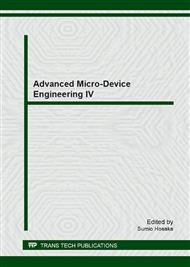[1]
(a) B. O'Regan and M. Grätzel: Nature Vol. 353 (1991).
Google Scholar
[2]
(a) K. Kakiage, Y. Nakada, T. Kogure, M. Yamamura, T. Kyomen, M. Unno and M. Hanaya: Silicon Chem. Vol. 3 (2008).
DOI: 10.1007/s11201-008-9032-8
Google Scholar
[3]
(a) K. Kakiage, E. Fujimura, H. Mine, T. Izumizawa, T. Katoh, K. Yoshimura, S. Kyushin, T. Kyomen and M. Hanaya: Chem. Lett. Vol. 39 (2010).
DOI: 10.1246/cl.2010.1063
Google Scholar
[4]
A. Yella, H. -W. Lee, H.N. Tsao, C. Yi, A.K. Chandiran, M.K. Nazeeruddin, E.W. -G. Diau, C. -Y. Yeh, S.M. Zakeeruddin and M. Grätzel: Science Vol. 334 (2011), p.629.
DOI: 10.1126/science.1209688
Google Scholar
[5]
(a) G. Oskam, B.V. Bergeron, G.J. Meyer and P.C. Searson: J. Phys. Chem. B Vol. 105 (2001), p.6867; (b) H. Tian and L. Sun: J. Mater. Chem. Vol. 21 (2011), p.10592; (c) T.W. Hamann and J.W. Ondersma: Energy Environ. Sci. Vol. 4 (2011), p.370.
Google Scholar
[6]
Z. Ning, Y. Fu and H. Tian: Energy Environ. Sci. Vol. 3 (2010), p.1170.
Google Scholar
[7]
(a) Z. -S. Wang, K. Sayama and H. Sugihara: J. Phys. Chem. B Vol. 109 (2005).
Google Scholar
[8]
S. Ito, T.N. Murakami, P. Comte, P. Liska, C. Grätzel, M.K. Nazeeruddin and M. Grätzel: Thin Solid Films Vol. 516 (2008), p.4613.
DOI: 10.1016/j.tsf.2007.05.090
Google Scholar
[9]
R.S.H. Liu and A.E. Asato: J. Photochem. Photobiol. C: Photochem. Rev. Vol. 4 (2003), p.179.
Google Scholar
[10]
Details will be reported in other papers.
Google Scholar
[11]
A. Islam, S.P. Singh and L. Han: Int. J. Photoenergy Vol. 2011 (2011), p.204639.
Google Scholar
[12]
S.R. Raga, E.M. Barea and F. Fabregat-Santiago: J. Phys. Chem. Lett. Vol. 3 (2012), p.1629.
Google Scholar
[13]
T. Kanzaki, S. Nakade, Y. Wada and S. Yanagida: Photochem. Photobiol. Sci. Vol. 5 (2006), p.389.
Google Scholar
[14]
C. Zhang, Y. Huang, Z. Huo, S. Chen and S. Dai: J. Phys. Chem. C Vol. 113 (2009), p.21779.
Google Scholar
[15]
M. Wang, N. Chamberland, L. Breau, J. -E. Moser, R. Humphry-Baker, B. Marsan, S.M. Zakeeruddin and M. Grätzel: Nat. Chem. Vol. 2 (2010), p.385.
DOI: 10.1038/nchem.610
Google Scholar



